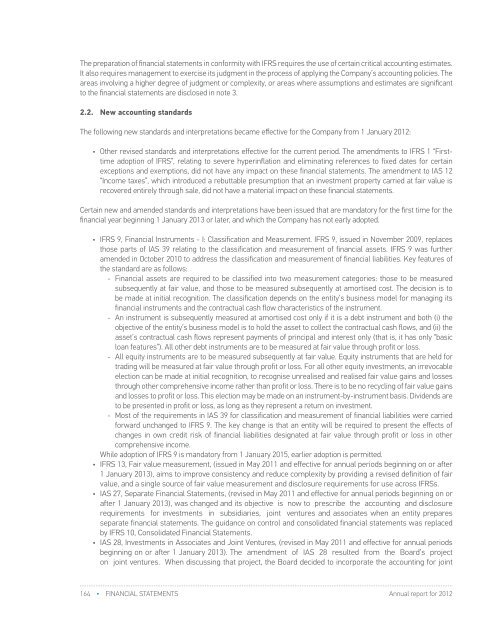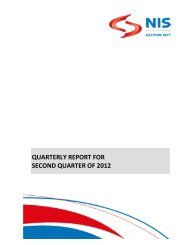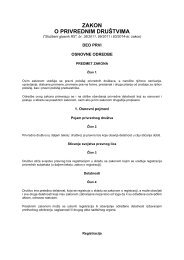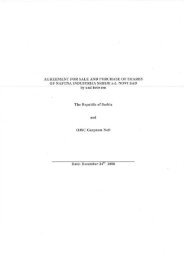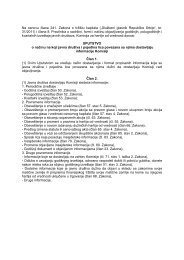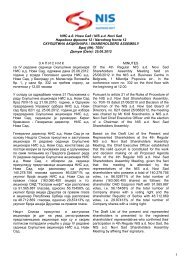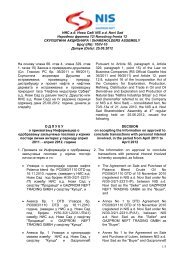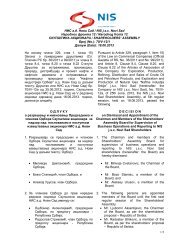FY 2012 - Investor Relations - NIS
FY 2012 - Investor Relations - NIS
FY 2012 - Investor Relations - NIS
Create successful ePaper yourself
Turn your PDF publications into a flip-book with our unique Google optimized e-Paper software.
The preparation of financial statements in conformity with IFRS requires the use of certain critical accounting estimates.It also requires management to exercise its judgment in the process of applying the Company’s accounting policies. Theareas involving a higher degree of judgment or complexity, or areas where assumptions and estimates are significantto the financial statements are disclosed in note 3.2.2. New accounting standardsThe following new standards and interpretations became effective for the Company from 1 January <strong>2012</strong>:• Other revised standards and interpretations effective for the current period. The amendments to IFRS 1 “Firsttimeadoption of IFRS”, relating to severe hyperinflation and eliminating references to fixed dates for certainexceptions and exemptions, did not have any impact on these financial statements. The amendment to IAS 12“Income taxes”, which introduced a rebuttable presumption that an investment property carried at fair value isrecovered entirely through sale, did not have a material impact on these financial statements.Certain new and amended standards and interpretations have been issued that are mandatory for the first time for thefinancial year beginning 1 January 2013 or later, and which the Company has not early adopted.• IFRS 9, Financial Instruments - I: Classification and Measurement. IFRS 9, issued in November 2009, replacesthose parts of IAS 39 relating to the classification and measurement of financial assets. IFRS 9 was furtheramended in October 2010 to address the classification and measurement of financial liabilities. Key features ofthe standard are as follows:--Financial assets are required to be classified into two measurement categories: those to be measuredsubsequently at fair value, and those to be measured subsequently at amortised cost. The decision is tobe made at initial recognition. The classification depends on the entity’s business model for managing itsfinancial instruments and the contractual cash flow characteristics of the instrument.--An instrument is subsequently measured at amortised cost only if it is a debt instrument and both (i) theobjective of the entity’s business model is to hold the asset to collect the contractual cash flows, and (ii) theasset’s contractual cash flows represent payments of principal and interest only (that is, it has only “basicloan features”). All other debt instruments are to be measured at fair value through profit or loss.--All equity instruments are to be measured subsequently at fair value. Equity instruments that are held fortrading will be measured at fair value through profit or loss. For all other equity investments, an irrevocableelection can be made at initial recognition, to recognise unrealised and realised fair value gains and lossesthrough other comprehensive income rather than profit or loss. There is to be no recycling of fair value gainsand losses to profit or loss. This election may be made on an instrument-by-instrument basis. Dividends areto be presented in profit or loss, as long as they represent a return on investment.--Most of the requirements in IAS 39 for classification and measurement of financial liabilities were carriedforward unchanged to IFRS 9. The key change is that an entity will be required to present the effects ofchanges in own credit risk of financial liabilities designated at fair value through profit or loss in othercomprehensive income.While adoption of IFRS 9 is mandatory from 1 January 2015, earlier adoption is permitted.• IFRS 13, Fair value measurement, (issued in May 2011 and effective for annual periods beginning on or after1 January 2013), aims to improve consistency and reduce complexity by providing a revised definition of fairvalue, and a single source of fair value measurement and disclosure requirements for use across IFRSs.• IAS 27, Separate Financial Statements, (revised in May 2011 and effective for annual periods beginning on orafter 1 January 2013), was changed and its objective is now to prescribe the accounting and disclosurerequirements for investments in subsidiaries, joint ventures and associates when an entity preparesseparate financial statements. The guidance on control and consolidated financial statements was replacedby IFRS 10, Consolidated Financial Statements.• IAS 28, Investments in Associates and Joint Ventures, (revised in May 2011 and effective for annual periodsbeginning on or after 1 January 2013). The amendment of IAS 28 resulted from the Board’s projecton joint ventures. When discussing that project, the Board decided to incorporate the accounting for jointventures using the equity method into IAS 28 because this method is applicable to both joint ventures andassociates. With this exception, other guidance remained unchanged.• Amendments to IAS 1, Presentation of Financial Statements (issued June 2011, effective for annual periodsbeginning on or after 1 July <strong>2012</strong>), changes the disclosure of items presented in other comprehensive income.The amendments require entities to separate items presented in other comprehensive income into twoCompanies, based on whether or not they may be reclassified to profit or loss in the future. The suggestedtitle used by IAS 1 has changed to ‘statement of profit or loss and other comprehensive income’. The Companyexpects the amended standard to change presentation of its financial statements, but have no impact onmeasurement of transactions and balances.• Amended IAS 19, Employee Benefits (issued in June 2011, effective for periods beginning on or after 1 January2013), makes significant changes to the recognition and measurement of defined benefit pension expenseand termination benefits, and to the disclosures for all employee benefits. The standard requires recognitionof all changes in the net defined benefit liability (asset) when they occur, as follows: (i) service cost and netinterest in profit or loss; and (ii) remeasurements in other comprehensive income.• Disclosures—Offsetting Financial Assets and Financial Liabilities - Amendments to IFRS 7 (issued inDecember 2011 and effective for annual periods beginning on or after 1 January 2013). The amendmentrequires disclosures that will enable users of an entity’s financial statements to evaluate the effect or potentialeffect of netting arrangements, including rights of set-off.• Offsetting Financial Assets and Financial Liabilities - Amendments to IAS 32 (issued in December 2011and effective for annual periods beginning on or after 1 January 2014). The amendment added applicationguidance to IAS 32 to address inconsistencies identified in applying some of the offsetting criteria. Thisincludes clarifying the meaning of ‘currently has a legally enforceable right of set-off’ and that some grosssettlement systems may be considered equivalent to net settlement.• Improvements to International Financial Reporting Standards (issued in May <strong>2012</strong> and effective for annualperiods beginning 1 January 2013). The improvements consist of changes to five standards. IFRS 1 wasamended to (i) clarify that an entity that resumes preparing its IFRS financial statements may either repeatedlyapply IFRS 1 or apply all IFRSs retrospectively as if it had never stopped applying them, and (ii) to add anexemption from applying IAS 23 “Borrowing costs”, retrospectively by first-time adopters. IAS 1 was amendedto clarify that explanatory notes are not required to support the third balance sheet presented at the beginningof the preceding period when it is provided because it was materially impacted by a retrospective restatement,changes in accounting policies or reclassifications for presentation purposes, while explanatory notes willbe required when an entity voluntarily decides to provide additional comparative statements. IAS 16 wasamended to clarify that servicing equipment that is used for more than one period is classified as property,plant and equipment rather than inventory. IAS 32 was amended to clarify that certain tax consequences ofdistributions to owners should be accounted for in the income statement as was always required by IAS 12.IAS 34 was amended to bring its requirements in line with IFRS 8. IAS 34 will require disclosure of a measureof total assets and liabilities for an operating segment only if such information is regularly provided to chiefoperating decision maker and there has been a material change in those measures since the last annualfinancial statements.• Transition Guidance Amendments to IFRS 10, IFRS 11 and IFRS 12 (issued in June <strong>2012</strong> and effective for annualperiods beginning 1 January 2013). The amendments clarify the transition guidance in IFRS 10 “ConsolidatedFinancial Statements”. Entities adopting IFRS 10 should assess control at the first day of the annual period inwhich IFRS 10 is adopted, and if the consolidation conclusion under IFRS 10 differs from IAS 27 and SIC 12,the immediately preceding comparative period (that is, year <strong>2012</strong> for a calendar year-end entity that adoptsIFRS 10 in 2013) is restated, unless impracticable. The amendments also provide additional transition relief inIFRS 10, IFRS 11 “Joint Arrangements” and IFRS 12 “Disclosure of Interests in Other Entities”, by limiting therequirement to provide adjusted comparative information only for the immediately preceding comparativeperiod. Further, the amendments will remove the requirement to present comparative information fordisclosures related to unconsolidated structured entities for periods before IFRS 12 is first applied.• Amendments to IFRS 1 “First-time adoption of International Financial Reporting Standards - GovernmentLoans“ (issued in March <strong>2012</strong> and effective for annual periods beginning 1 January 2013). The amendments,dealing with loans received from governments at a below market rate of interest, give first-time adopters of164 • FINANCIAL STATEMENTS Annual report for <strong>2012</strong>Annual report for <strong>2012</strong>FINANCIAL STATEMENTS • 165


